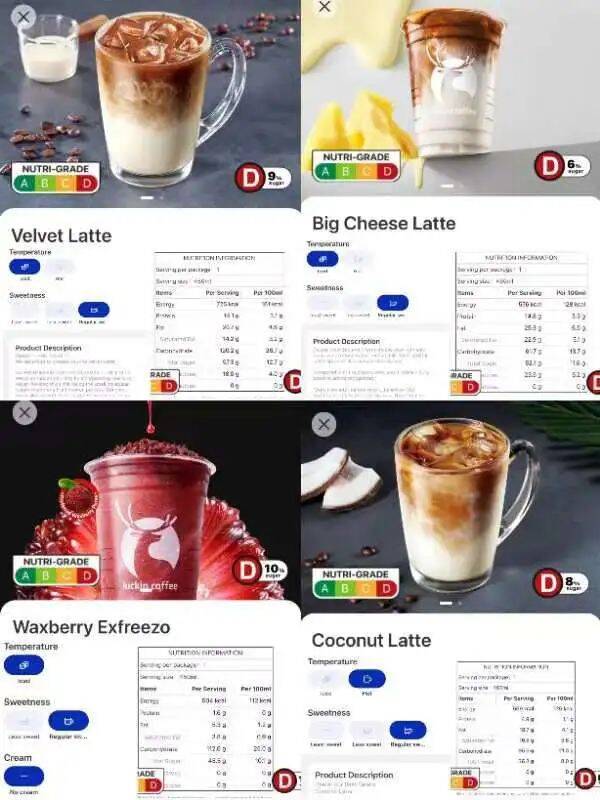The whole people fight against sugar! Lucky took the dirty off the shelves?!
▲
Click follow | Daily boutique coffee culture magazine coffee workshop
On the last day of last year, the Singapore government introduced the latest regulation of the Sugar restriction order, requiring all beverages, including packaged drinks and currently mixed drinks, to put on four different nutrition levels and sugar content labels corresponding to ABCD, prompting merchants to put on new "listed" menus overnight for consumers' reference.
Since the start of the "anti-sugar campaign" in Singapore, when ordering, entering the detailed page of drinks and checking their nutrition level labels has also become a knee-jerk move for many people before paying the bill.
Do not see do not know, a look startled, many netizens found that their favorite coffee is actually "the most unhealthy", as high as 910% sugar content, directly classified as C or D grade. On social platforms, how to grade each other's popular science and discuss the specific grade of the familiar drink has also become a hot topic among Singaporean Chinese.
Perhaps because of the conjecture that the implementation of the "anti-sugar policy" will have a certain impact on consumers' purchase decisions, some netizens have found that many chain brands have made different adjustments in their menus or raw materials intentionally or unintentionally.

Singapore's national milk tea brand KOI The directly announced that it had lowered the sugar content of its drinks, because without adjusting the original sugar content, most of the drinks on the menu could hardly avoid the "D grade", which is considered the most unhealthy. In that case, it is likely to directly affect everyone's desire for consumption.
Mr coconut, another local smoothie brand, has a reduced sugar version of the lite series, which greatly reduces the amount of sugar used. At the same time, individual drinks replace sugar raw materials with edible sugar, or by reducing the amount of excipients (such as ice cream, pearls, etc.), but the adjustment of ingredients has also directly repelled many sweet consumers, repeatedly saying that it is not as good as the original.
In addition to milk tea shops, coffee brands are no exception. A careful comparison of netizens found that several Dirty models of Singapore Lucky "disappeared" directly from the menu, and even ice-sucking coconut lattes were removed from the shelves. However, there are still a large number of D drinks in the catalogue, such as raw coconut latte, velvet latte, cheese latte, bayberry Reina ice and so on.

With regard to the mandatory division of nutrition level labels in Singapore, many consumers agree that different color labels have a great impact, so that people who lose weight and have high sugar intake can consciously choose grade An or B beverages. in order to achieve effective sugar control in life.
However, because the algorithm of this grade label contains not only sugar content, but also the proportion of saturated fat, many sugar-free milk drinks have no choice but to "lie down" and are forced to "lower". As a result, many consumers believe that since non-sugary drinks such as pure milk and sugar-free lattes are also marked as Class C, this label is of little reference value for people who don't drink sugary drinks very often.
Disclaimer: some of the pictures in this article come from the network, and some of the contents of the website, such as pictures, we will respect the origin of the original copyright, but due to the large number, there will be individual pictures and texts not in time to indicate, please forgive me. If the original author has any disputes can contact the website to deal with, once verified we will immediately correct, by the "coffee workshop" collation and editing, reprint please indicate, if infringement, please inform deletion, thank you ~!
Important Notice :
前街咖啡 FrontStreet Coffee has moved to new addredd:
FrontStreet Coffee Address: 315,Donghua East Road,GuangZhou
Tel:020 38364473
- Prev

WCR is about to launch the Robusta breeding program, and trials have been conducted to plant Robusta varieties in Uganda.
Over the past few decades, Robusta has grown into a major market force for coffee, rising from 25% to 40% of global coffee production since the early 1990s. Judging from the current situation, the demand for Robusta will increase in the future. However, Robusta's planting also
- Next

Shake coffee, workers do not want to use their brains to change careers first choice!
▲ Click follow: daily boutique Coffee Culture Magazine Coffee Workshop "Ali resigned and switched to barista!"A big company resigned naked and became a barista, happy and rich."Internet turned barista, who is not a part-time job!"about my thoughts on the year when I transferred from design institute to Starbucks." In each
Related
- Being chased out of the rain in front of Starbucks?! Store: Sheltering from rain under umbrellas poses a safety hazard
- The white moonlight has changed?! Lucky launches "Big Winter Pear American"
- Hand-brewed coffee three-stage method, high-sweet and universal brewing method to share! What does the high sweet water level of hand-brewed coffee mean?
- What is the difference between raw, refined and full espresso coffee? How to extract espresso and taste good?
- A complete list of coffee bean names and their meanings! What is Yejia Shefi coffee? Where is Mantelin coffee?
- What grade does Arida Manor Kaduai coffee beans belong to? What treatment is Arida ASD slow anaerobic sun exposure?
- The milk tea cup becomes smaller?! Overlord Tea Girl launches a new "Return to Yunnan" series
- Accused of selling counterfeit and high-priced coffee beans! Well-known boutique coffee brand "Oukelao" bowed and apologized!
- How to make espresso dumplings? Can I eat coffee and glutinous rice balls together?
- Save the unformed and stagnant powder cakes in one second! What is the problem with stagnant water in the powder bowl of the espresso machine?

